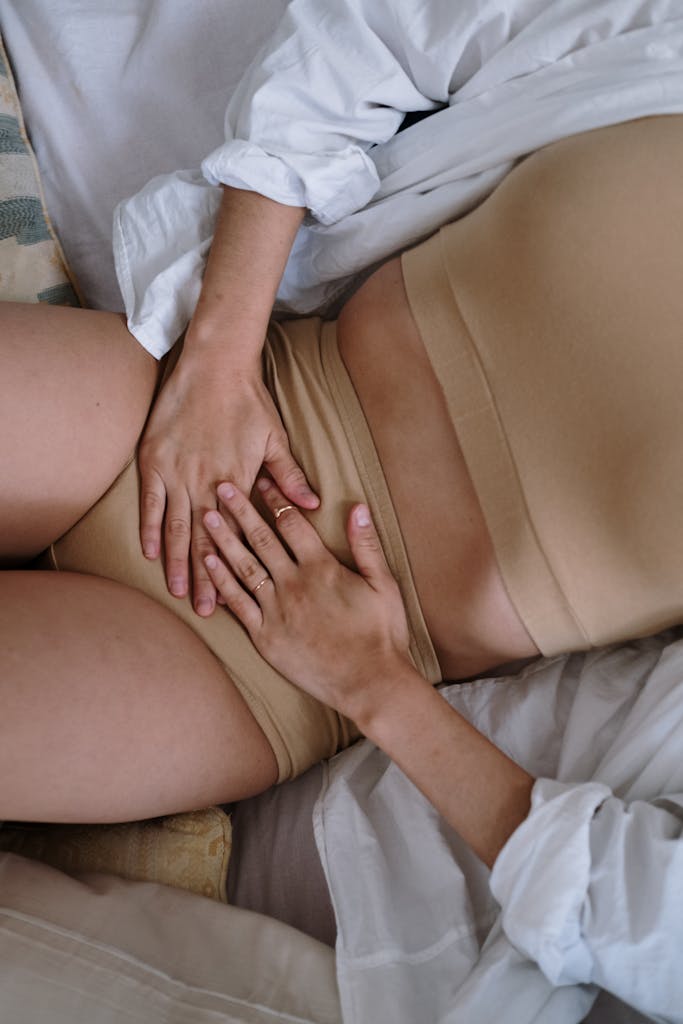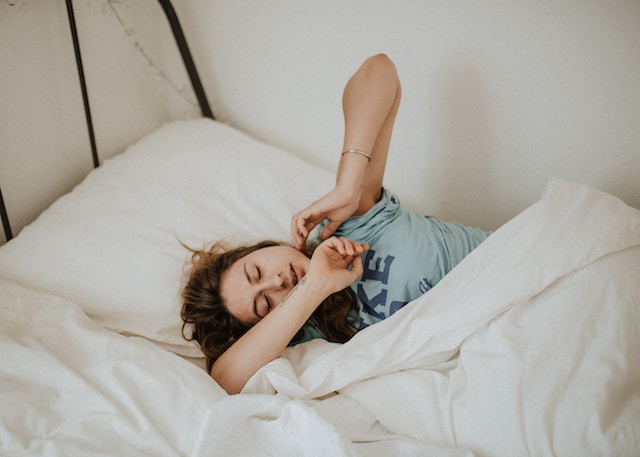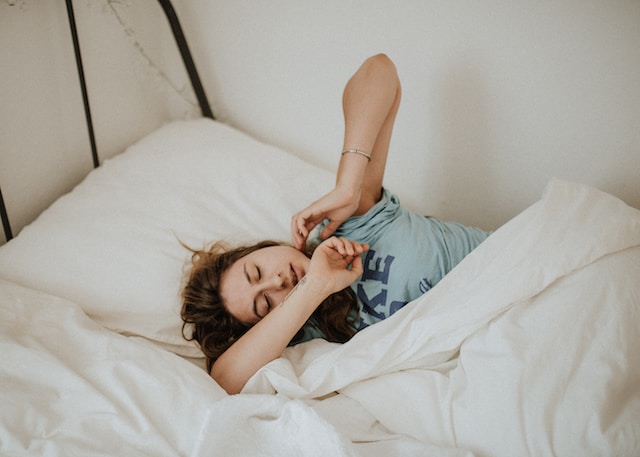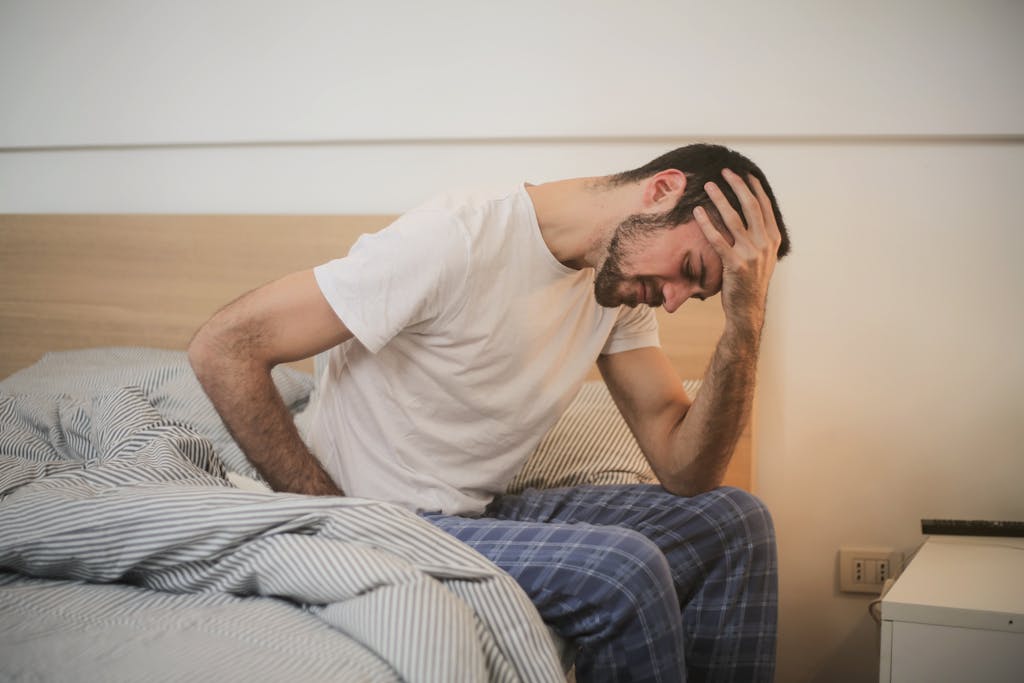Best Sleeping Position for Menstrual Cramps: Tips and Tricks
There are some affiliate links below, but they are all products I highly recommend. For more info, view my disclosure here.
When it comes to menstrual cramps, getting a good night’s sleep can be a challenge. The discomfort and pain can make it difficult to find a comfortable position to sleep in. However, there are certain sleeping positions that can help alleviate menstrual cramps and improve your sleep quality.
One of the best positions to sleep with menstrual cramps is on your side. Sleeping on your side can help take pressure off your lower back and pelvis, which can reduce cramping. Placing a pillow between your knees can help align your hips and reduce strain on your lower back.
Another position that may be helpful is sleeping in the fetal position. This involves lying on your side with your knees bent and tucked up towards your chest. This position can help stretch out the lower back and reduce tension in the abdominal muscles. However, it’s important to avoid curling up too tightly, as this can restrict breathing and cause discomfort in the neck and shoulders.

Understanding Menstrual Cramps and Sleep
If you are someone who experiences menstrual cramps, you know how difficult it can be to get a good night’s sleep during your period. Menstrual cramps are caused by the release of hormones and prostaglandins, which can lead to pain and discomfort. In this section, we will explore the relationship between menstrual cramps and sleep, and how you can manage your symptoms to get a better night’s rest.
Role of Hormones and Prostaglandins
Menstrual cramps are caused by the release of hormones, such as progesterone and estrogen, which help regulate the menstrual cycle. These hormones cause the uterus to contract, which can lead to pain and discomfort. The release of prostaglandins, which are hormone-like substances, can cause inflammation and pain in the uterus.
Impact of Menstrual Pain on Sleep Patterns
Menstrual pain can have a significant impact on your sleep patterns. Pain and discomfort can make it difficult to fall asleep and stay asleep, leading to sleep disturbances and fatigue. Menstrual cramps can disrupt your circadian rhythm, which can affect your body’s natural sleep-wake cycle.
To manage your menstrual cramps and get a better night’s sleep, there are several things you can do. First, try taking over-the-counter pain relief medication, such as ibuprofen or acetaminophen, to help manage your symptoms. Using a heating pad or taking a warm bath can help relax your muscles and ease your pain.
Menstrual cramps can have a significant impact on your sleep patterns, but there are steps you can take to manage your symptoms and get a better night’s rest. By understanding the role of hormones and prostaglandins in menstrual cramps, and taking steps to manage your pain and discomfort, you can improve your overall sleep quality and wake up feeling refreshed and rejuvenated.
Optimal Sleeping Positions for Menstrual Cramps
When it’s that time of the month, menstrual cramps can make it difficult to get a good night’s sleep. Luckily, there are a few sleeping positions that can help alleviate the pain and discomfort.
Fetal Position and Its Benefits
The fetal position is one of the most popular sleeping positions for those experiencing menstrual cramps. This position involves lying on your side with your knees tucked up towards your chest. This position is beneficial because it can help alleviate cramps by reducing the pressure on your abdominal muscles.
To get into the fetal position, lie on your side and bring your knees up towards your chest. You can also place a pillow between your knees to help keep your spine in alignment and reduce lower back pain.
Back Sleeping and Knee Support
Sleeping on your back with a pillow under your knees can also help alleviate menstrual cramps. This position helps to reduce pressure on the lower back and pelvis, which can help alleviate cramps.
To get into this position, lie on your back and place a pillow under your knees. This will help keep your spine in alignment and reduce lower back pain.
Finding the right sleeping position can make a big difference when it comes to alleviating menstrual cramps. Experiment with these positions to see which one works best for you and try using a pillow or other support to help keep your body in alignment and reduce pain.
Lifestyle and Home Remedies
Menstrual cramps can be quite uncomfortable, but there are a few lifestyle changes and home remedies that can help alleviate the pain. Here are some tips to help you manage menstrual cramps:
Diet and Hydration
Your diet and hydration play a significant role in managing menstrual cramps. Eating a balanced diet rich in fruits, vegetables, and whole grains can help reduce inflammation and ease cramps. Staying hydrated by drinking plenty of water and avoiding caffeine and alcohol can help reduce bloating and cramps.
Exercise and Yoga
Exercise and yoga can also help reduce menstrual cramps. Regular exercise can help increase blood flow and reduce inflammation, which can ease cramps. Yoga, in particular, can be beneficial as it helps stretch and strengthen the muscles, which can reduce cramps. Try incorporating gentle exercises like walking, swimming, or yoga into your routine.
Heat Therapy and Massage
Heat therapy and massage can also help alleviate menstrual cramps. Applying heat to your lower abdomen or back using a heating pad or hot water bottle can help relax the muscles and reduce cramps. Getting a massage can help reduce tension and alleviate pain. You can also try massaging your lower abdomen or back yourself.
Self-care is crucial when managing menstrual cramps. By making small lifestyle changes and trying home remedies like ginger tea or a hot water bottle, you can help alleviate the pain and discomfort of menstrual cramps.
Managing Stress and Emotional Well-being
When experiencing menstrual cramps, managing stress and emotional well-being can be just as important as physical relief. Here are some techniques to help you relax and maintain your mental health during this time.
Relaxation Techniques
Relaxation techniques can help reduce stress and anxiety, which can in turn alleviate menstrual cramps. Some techniques you can try include:
- Deep breathing exercises: Inhale deeply through your nose, hold the breath for a few seconds, and exhale slowly through your mouth. Repeat this for a few minutes.
- Progressive muscle relaxation: Tense and relax different muscle groups in your body, starting from your toes and working your way up to your head.
- Yoga: Certain yoga poses, such as child’s pose and pigeon pose, can help relieve menstrual cramps.
Mental Health and Mood Swings
Premenstrual syndrome (PMS) symptoms, including mood swings, can also affect your emotional well-being during menstrual cramps. Here are some tips to help manage your mental health:
- Maintain a healthy diet: Eating a balanced diet with plenty of fruits, vegetables, and whole grains can help regulate your mood.
- Exercise: Regular exercise can help reduce stress and boost your mood.
- Seek support: Talking to a trusted friend or family member, or seeking professional help, can provide emotional support and help you manage any feelings of anxiety or depression.
By taking care of your emotional well-being, you can improve your quality of life during menstrual cramps.
Medical Interventions and Considerations
Medications for Pain Management
When menstrual cramps become too painful to bear, over-the-counter pain medications such as ibuprofen can be helpful. Ibuprofen is a nonsteroidal anti-inflammatory drug (NSAID) that can help reduce inflammation and alleviate pain. Follow the recommended dosage and not exceed the daily limit.
If over-the-counter pain medications are not enough to manage your menstrual cramps, your doctor may prescribe stronger pain medications. These may include prescription NSAIDs or opioids. Note that opioids can be addictive and should only be used under the guidance of a doctor.
Birth Control and Hormonal Regulation
Birth control pills can be an effective way to manage menstrual cramps. They work by regulating the hormones that cause the painful cramps. Birth control pills can also help regulate your menstrual cycle, making it more predictable and less painful.
In addition to birth control pills, other hormonal contraceptives such as the patch, ring, or hormonal intrauterine device (IUD) can also be effective in managing menstrual cramps. Discuss the risks and benefits of these options with your doctor before starting any new medication.
Note that hormonal changes can affect menstrual cramps. For example, women may experience more painful cramps during puberty, pregnancy, or menopause. Discuss any changes in menstrual cramps with your doctor to determine the best course of action.
There are several medical interventions and considerations that can help manage menstrual cramps. From over-the-counter pain medications to hormonal regulation through birth control, there are options available to help alleviate the discomfort of painful cramps.






